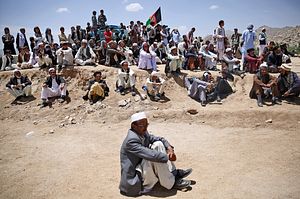After more than two months of electoral crisis in Ghazni province, Afghanistan’s Independent Elections Commission (IEC) announced on June 25 that the province has been divided into three constituencies, a decision that spurred sharp criticism from Ghazni residents, civil society, and their representatives in parliament. Rather than an end to the electoral stalemate in Ghazni, the decision looks to be the beginning of a new crisis tied very much into the ethnic agenda to increase Pashtun representation in the legislature.
Voter registration for the 2018 parliamentary and districts council elections was launched across Afghanistan on April 14, first in the capital and provincial centers, followed by district centers and villages. Candidate registration for the two elections began on May 26 for a period of 12 days.
Ghazni was the only province where voter and candidate registration was suspended, thus only a limited number of voters registered while no candidates could register to run for parliament or the district council. A debate on the issue during a session in the parliament broke into physical fight.
According to the IEC’s decision, Ghazni will be divided into three smaller constituencies, placing pockets of ethnic minorities in each constituency, a fact that has the potential to instigate ethnic conflict. According to the decision, one constituency is Hazara-dominated with small pockets of Pashtun minorities, while the other two are Pashtun-dominated with pockets of Hazara and Tajik minorities. This leaves Hazaras with a weak chance of getting even four seats out of the 11 reserved for the province, while they arguably make up half of the population. There have also been concerns raised over women’s representation as the current division has allocated a three-seat quota for the female demographic.
As representatives of Ghazni in the parliament have highlighted in a statement, in addition to being unconstitutional, the decision is a breach of articles 35, 36, and 71 of the current elections law, and therefore lacks a legal basis. Article 36, among other things, clearly stipulates that “The boundaries of electoral constituencies shall be determined at least 180 days before the election day.” In fact, the government rejected a plan to reduce electoral constituencies — which would have divided all provinces into constituencies on the basis of the population — in late May on the same legal basis.
The decision to reduce Ghazni alone could be the match that sets powder keg of ethnic conflict alight, sowing division in the province and beyond, dividing the people along ethnic lines ahead of the October parliamentary and 2019 presidential elections. The Hazaras of Qarabagh district in the Ghazni have lived with the fear of an ethnic conflict for the past few weeks. Meanwhile, and in a surprise move, the Taliban declared an ultimatum for Jaghori district to either submit to the group and welcome the newly appointed shadow governor and police chief or prepare for war. This comes after the Taliban announced shadow governors for Jaghori, Malistan, and Nahor districts, all of which fall in the Hazara-dominated controversial electoral constituency. The local perception holds that the ultimatum was declared in tandem with the government decision to implement the three-constituency decision.
As the opposition to the decision gradually gathers momentum, the debate around the issue sharpens, identifying the recent discriminatory decision as symptomatic of deeper inequalities and ethnic disparities in the province. Some have pointed to the unwritten law that no Hazaras can become governor or police chief of the province that speaks of a deep-rooted institutional bias against an ethnic group that arguably comprises close to half of the population in the province.
One remedy proposed is a two-province solution that is argued to be both a legal and fair end to the present crisis. The idea has been in circulation since at least the 2009 presidential election, in which the promise to give the Hazaras of Ghazni a separate province was bartered in exchange for their votes. The same card was played by current President Ashraf Ghani during the 2014 presidential campaign. A seducing campaign promise in the 2009 and 2014 presidential elections, the issue of a separate province has once again surfaced in the recent debates following the IEC decision.
Dividing Ghazni into smaller electoral constituencies seems to be a first step for smaller constituencies that are modeled on the historical formula of dividing ethnic groups as minority pockets in Pashtun provinces to keep the Pashtuns a dominant majority across the country. For the electoral constituencies to be engineered in the same vein, Ghazni was among the most difficult provinces of all given its ethnic composition. Thus, the recent decision seems to be a pilot program for the hotly controversial plan of dividing all big provinces into smaller constituencies.
The IEC’s decision is in no way an end to the election crisis in Ghazni province; rather it is the beginning of a problem rooted in pre-existing ethnic divides that have the potential to tear apart the already poorly woven social fabric in Ghazni and across the country. If there is only one way for Afghanistan to gain political stability and social peace, it is a fair democratic process that accommodates the legitimate demands and rights of all ethnic groups.
Bismellah Alizada is deputy director at the Kabul-based Organization for Policy Research and Development Studies (DROPS). The views expressed here are his own and do not necessarily reflect those of DROPS.

































